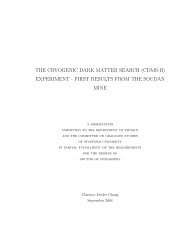Development of a Dilution Refrigerator for Low-Temperature ...
Development of a Dilution Refrigerator for Low-Temperature ...
Development of a Dilution Refrigerator for Low-Temperature ...
- No tags were found...
You also want an ePaper? Increase the reach of your titles
YUMPU automatically turns print PDFs into web optimized ePapers that Google loves.
Thermal links fromHe-3 pots (0.4 K)Pure He-3Phase boundary (cooling occurs)He-3Dilute He-3Mixing chamber(0.1 K)Still (0.6 K)6Condenser (0.4 K)He-3 gasHe-3 gaspumping lineSinter connecting linesPure He-3Dilute He-3Figure 5. Details <strong>of</strong> the low-temperature chambers <strong>of</strong> the continuously-operating dilution refrigerator.condenser is cooled to maintain its temperature at 0.4 K, He-3 will be continuously pumped fromthe still into the condenser and <strong>for</strong>ced back into the mixing chamber. This continuous circulation<strong>of</strong> He-3 will produce continuous cooling in the mixing chamber where He-3 crosses the phaseboundary from pure He-3 into the He-4.The notable feature <strong>of</strong> this design is the method by which the condenser is continuouslycooled (while maintaining the advantages <strong>of</strong> compactness, reliability and the complete absence <strong>of</strong>moving parts). The condenser is cooled by a pair <strong>of</strong> independent, single-cycle He-3 refrigerators(see Fig. 6), each with its own charcoal pump, and each thermally linked to the condenser by agas-gap heat switch. While one He-3 pot is cold and coupled to the condenser, the other He-3 potis isolated from the condenser while it is being refilled at high temperature. Then, be<strong>for</strong>e the firstHe-3 pot runs empty, the second He-3 pot would be cooled down and coupled to the condenserby its heat switch. The first He-3 pot could then be decoupled and refilled and there would havebeen no interruption <strong>of</strong> cooling to the condenser.CONCLUSIONSWe have built a 'shallow' single-cycle dilution refrigerator to demonstrate the principle <strong>of</strong> capillaryconfinement in a refrigerator that can reach 0.1 K or below in microgravity. We have designeda continuously-cooling version <strong>of</strong> a dilution refrigerator that builds on the design <strong>of</strong> thesingle-cycle refrigerator while maintaining its advantage <strong>of</strong> no moving parts. The continuouslycoolingversion will be very useful by itself <strong>for</strong> microgravity experiments that require cooling to aslow as 0.04 K; it will also be invaluable <strong>for</strong> experiments that require temperatures as low as 0.001K because it can be used to precool adiabatic demagnetization systems that can reach those temperatures.REFERENCES1. Roach, P. R. and Gray, K. E., "<strong>Low</strong>-Cost, Compact <strong>Dilution</strong> <strong>Refrigerator</strong>: Operation from 200 to 20mK", Advances in Cryogenic Engineering, vol. 33, Plenum Press, New York (1988), pp. 707-712.2. Roach, Pat R., "Thermal Efficiency <strong>of</strong> a Zero-G <strong>Dilution</strong> <strong>Refrigerator</strong>", Proc. Fifth Intern. CryocoolersConf., Monterey, CA (August 1988) pp.195-204.3. Roach, Pat R , and Helvensteijn, Ben, "<strong>Development</strong> <strong>of</strong> a Compact <strong>Dilution</strong> <strong>Refrigerator</strong> <strong>for</strong> Zero




